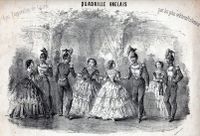Annotation:Lancers Quadrilles First Figure (The)
Back to Lancers Quadrilles First Figure (The)
LANCERS QUADRILLES, THE. AKA and see "Dorset (La)," "Graces (5) (Les)," "Lodioska." English, Lancers' Set. These are tunes for five figures grouped together for the purpose of extended dance figures collectively called "Lancers." The Lancers was "a nineteenth century square dance which flourished alongside the quadrille in the last quarter of the century, and outlived it into the early 20th century. The name was derived from the 'Quadrille des Lanciers' which was introduced in 1817 in Dublin by the dancing master John Duval. The five figures were La Dorset (music by Spagnoletti), Lodoiska (music by Rodolphe Kreutzer), La Native ('If the heart of man' from The Beggar's Opera), Les Graces {'Pretty Maiden' from Storace's The Haunted Tower} and Les Lanciers, music by Janiewicz)" {Trim quoting Groves Dictionary}.

1) La Dorset (6/8 time) -- F Major & D Minor. ABCDA.
2) Lodoiska (2/4 time) -- D Major. ABC,ABC,Coda.
3) La Native (6/8 time) -- D Major. ABA. (See note for "Would You Have a Young Virgin")
4) Les Graces (6/8 time) -- A Major, E Major, & A Minor. ABC,ABC.
5) Les Graces {Les Lanciers?} (4/4 time) -- C Major. AA'BB.
A dance called the "Lanciers Quadrille" was performed during the 150th anniversary celebration for the town of Lancaster, New Hampshire, in August, 1914, according to a playbill of the period; it was considered "old-fashioned" at that time. For another lancers set see "Trial By Jury" Lancers by Sir Arthur Sullivan.
The Ball Room Companion (Frederick Warne & Co., Covent Gardern, London, 1866), an instruction manual, says this about the Lancers:
Undoutedly the most popular quadrille after the First Set is the Lancers-- indeed, we are almost inclined to fancy that it is the most popular of any quadrilles. Many years ago this dance was a great favourite, but, owing to the freaks of fashion, it lapsed into obscurity, and was seldom, if ever, danced. We believe praise is due to the Empress Eugenie, to whom we are indebted for many things beside crinoline, for the re-introduction of this best of quadrilles into the modern ballroom.
The Lancers are more intricate and complicated than the First Set, hence it behoves those who essay to perform them to be especially careful to be quite perfect in the figure-bearing in mind that a single mistake will frequently spoil the entire quadrille. But once having thoroughly mastered the figure, the dancer will never forget it, for we know of no tunes which so completely suggest the figure as the old-fashioned music of the Lancers, which we are glad to see keeps its place in the ball programme, despite several attempts to introduce a variety of questionable compositions under the guise of New Lancers.
Source for notated version:
Printed sources: Trim (Thomas Hardy), 1990; No. 84.
Recorded sources:
